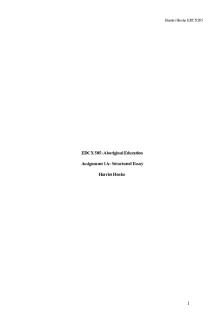BUS3DIG A1 - Digital Business Assignment one PDF

| Title | BUS3DIG A1 - Digital Business Assignment one |
|---|---|
| Author | Phoebe Bowen |
| Course | Digital Business |
| Institution | La Trobe University |
| Pages | 3 |
| File Size | 111.8 KB |
| File Type | |
| Total Downloads | 75 |
| Total Views | 151 |
Summary
Digital Business Assignment one...
Description
Formative and reflective task 1 – BUS3DIG Phoebe Bowen 20348426 Carleigh 1pm Tuesday Media and Communications EXTENSION GRANTED SATURDAY 20 MARCH. Question 1: The key dimensions of the Government’s $800m Digital Business plan involve putting forth a large budget to support businesses in recovering, building back, and creating more jobs to insist on the economic recovery plan. There are plans to develop a Digital Identity system and put funds towards modernising business registers, accelerating and supporting the rollout of 5G, boosting Australia’s international influence, adopting electronic invoicing, digital skills training for small and medium businesses and encouraging virtual meetings. These may accelerate the Australian digital transformation plan by providing businesses access to cutting-edge technology that could transform their businesses allowing more time and new ideas to be made. Question 2: Rob Nicholls has explained the controversial aspects against the Government’s $800 Digital Business plan. Nicholls (2020) questioned how ready the government is to handle the responsibility associated with this scheme and how it fits in with similar schemes that have been announced by other departments such as the Australian Tax Office. Nicholls (2020) believes there are several technical and policy issues regarding digital identity that have already dogged the federal government this year. Nicholls (2020) mentions that cybersecurity has raised concerns the ATO’s login system can be compromised. Robb Nicholls finalised with the idea that new funds allocated under the JobMaker Digital Business Plan suggest that the challenge may not be met by the government at the end (Nicholls, 2020). Question 3: E-commerce is the buying and selling of goods and services via the internet, or the transmitting of funds or data, over an electronic network to complete the sales. E-commerce can be an alternative for brick-and-mortar stores; however, some companies choose to maintain both. (The Future of E-commerce, 2021) E-commerce operates in all four major market segments: business to business (B2B), business to consumer (B2C), consumer to consumer, and consumer to business. E-commerce gives consumers access to purchase almost all products and services. (Gardner, 2021) E-commerce has eight unique features: richness, ubiquity, interactivity, information density, personalisation/customisation, social technology, universal standards, and global reach. (LMS, 2021) An example of the widespread use of e-commerce are platforms like Amazon or eBay which have both contributed to the considerable growth in online retail. (SEARCHCIO, 2020)
Question 4: Digital business is the creation of new value chains and business opportunities/designs that traditional businesses cannot provide by blurring the digital and physical worlds. Digital business is different from e-commerce as it is the presence and integration of elements, connected and intelligent, with people and business. Digital businesses focus on creating value by using digital technology to drive growth, revenue and performance in ways that were impossible with traditional models. The analytics allow companies to better understand their consumers and use real-time data to back their digital decisions to leverage marketing tactics. (Komprise, 2021) Uber capitalising on the widespread use of smartphones is an example of digital Business. It is a platform that connects people and drivers via the internet while creating an experience that improves on what was previously available to people (eg. taxis) (Liferay.com, 2021). Question 5: The ubiquity of e-commerce technology is that it’s available everywhere: at work, at home, and elsewhere via mobile devices, anytime (LMS, 2021). From a consumer point of view, the ubiquity of e-commerce impacts consumers by reducing transaction costs – the costs of participating in a market. It makes it no longer needed that consumers have to spend time and money traveling to a market. The ubiquity of e-commerce reduces the mental effort required to transact in a marketplace. (Laudon, 2016) Netflix is also a great example of a company that switched to digital business and uses ecommerce to allow people to stream and consume content anywhere at any time (Liferay.com, 2021).
REFERENCES
2016. E Commerce Business Technology Society Global Laudon Solutions Manual. 1st ed. Laudon Solutions, pp.8-9. Dorner, K. and Edelmen, D., 2015. What digital really means. [online] Mckinsey and company. Available at: [Accessed 20 March 2021]. Gartner. 2021. Gartner IT (Information Technology) Research - Special Reports. [online] Available at: [Accessed 20 March 2021]. Investopedia. 2019. Electronic Commerce (e-commerce). [online] Available at: [Accessed 19 March 2021]. i-SCOOP. 2020. Digital business: transformation, disruption, optimization, integration. [online] Available at: [Accessed 19 March 2021]. Komprise. 2021. What Is Digital Business? Digital Business Definition – Komprise. [online] Available at: [Accessed 19 March 2021]. Liferay.com. 2021. Digital Business - The Evolving Business Strategy | Liferay. [online] Available at: [Accessed 19 March 2021]. Nicholls, R. (2020, September 29). Government’s $800m Digital Business plan will let you access myGov with facial recognition. The Conversation. Pm.gov.au. 2021. Digital Business Plan to Drive Australia's Economic Recovery | Prime Minister of Australia. [online] Available at: [Accessed 19 March 2021]. SearchCIO. 2019. What is E-Commerce? Definition and Meaning. [online] Available at: [Accessed 19 March 2021]. The Future of Customer Engagement and Experience. 2021. What is e-commerce? Examples, Benefits, Stats, Strategies. [online] Available at: [Accessed 19 March 2021]....
Similar Free PDFs

AMB330 A1 Digital Audit
- 11 Pages

A1 Gutsii Health - Digital Audit
- 12 Pages

One to one assignment
- 1 Pages

EDCX505 A1 - assignment
- 8 Pages

CIS101 A1 assignment
- 1 Pages

A1 safety - assignment
- 5 Pages

Assignment one
- 63 Pages

AMB263 A1 - assignment 1
- 9 Pages

DIMR MCQ Digital Business
- 21 Pages

SOWK 2020 - Assignment one
- 13 Pages

Digital Marketing Assignment
- 23 Pages
Popular Institutions
- Tinajero National High School - Annex
- Politeknik Caltex Riau
- Yokohama City University
- SGT University
- University of Al-Qadisiyah
- Divine Word College of Vigan
- Techniek College Rotterdam
- Universidade de Santiago
- Universiti Teknologi MARA Cawangan Johor Kampus Pasir Gudang
- Poltekkes Kemenkes Yogyakarta
- Baguio City National High School
- Colegio san marcos
- preparatoria uno
- Centro de Bachillerato Tecnológico Industrial y de Servicios No. 107
- Dalian Maritime University
- Quang Trung Secondary School
- Colegio Tecnológico en Informática
- Corporación Regional de Educación Superior
- Grupo CEDVA
- Dar Al Uloom University
- Centro de Estudios Preuniversitarios de la Universidad Nacional de Ingeniería
- 上智大学
- Aakash International School, Nuna Majara
- San Felipe Neri Catholic School
- Kang Chiao International School - New Taipei City
- Misamis Occidental National High School
- Institución Educativa Escuela Normal Juan Ladrilleros
- Kolehiyo ng Pantukan
- Batanes State College
- Instituto Continental
- Sekolah Menengah Kejuruan Kesehatan Kaltara (Tarakan)
- Colegio de La Inmaculada Concepcion - Cebu




